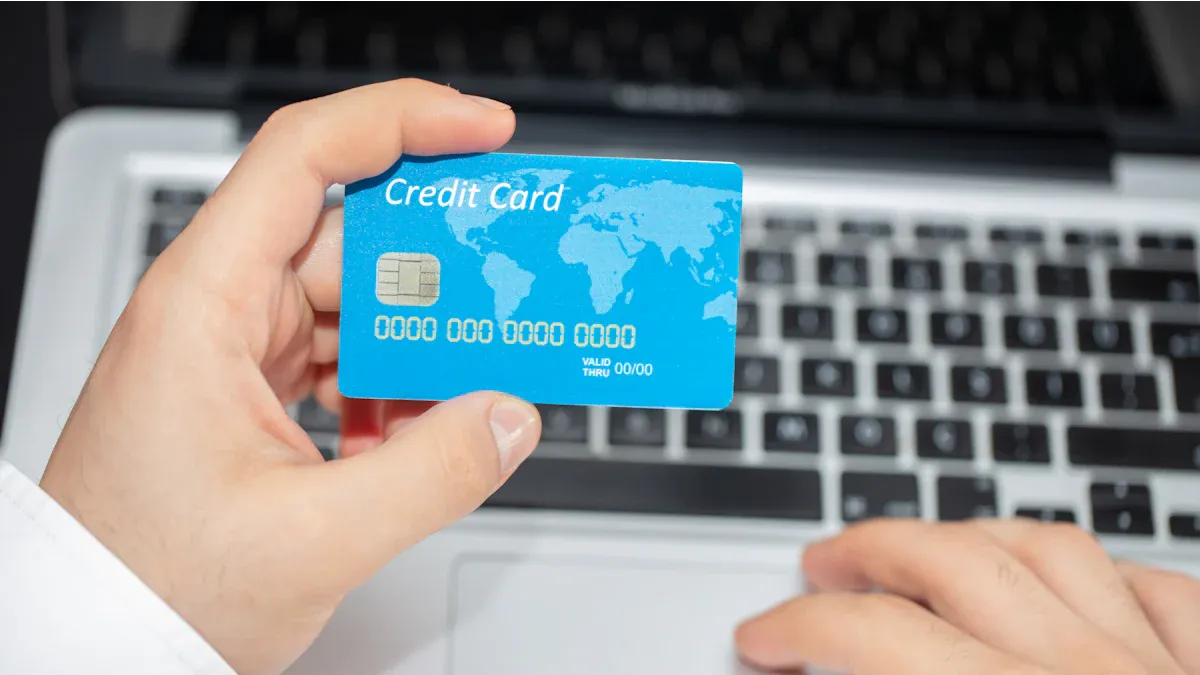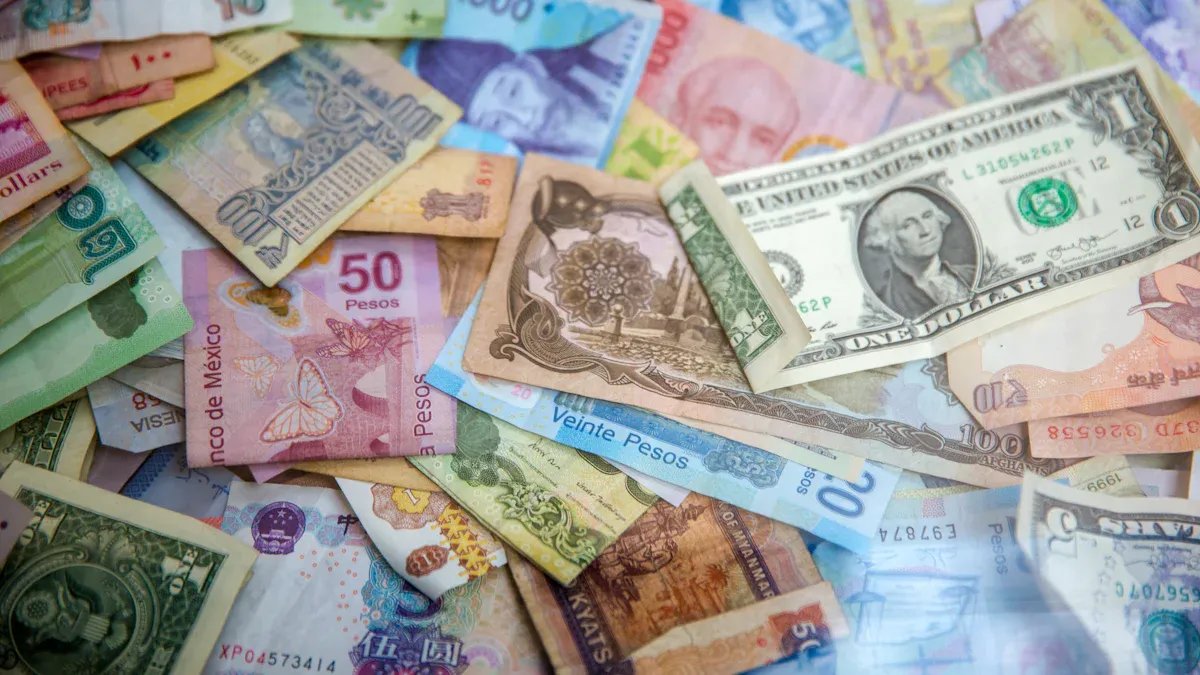- EasyCard
- Trade
- Help
- Announcement
- Academy
- SWIFT Code
- Iban Number
- Referral
- Customer Service
- Blog
- Creator
RIA Foreign Exchange Remittance Guide: Analysis of Exchange Rates, Fees, and Transaction Security

Image Source: pexels
Did you know? RIA is a company under the Euronet Group and is the world’s third-largest money transfer service provider.
When you plan to make an international money transfer, your primary concerns are likely three core issues: Are the exchange rates cost-effective, are the fees transparent, and is the transaction secure? This RIA Money Transfer Guide will help you thoroughly evaluate these key points to make the best choice for your needs.
Key Takeaways
- RIA’s exchange rates include a markup, which is lower than the mid-market rate, and this is one of RIA’s profit mechanisms.
- Transfer fees vary based on the amount, destination, and payment method, with bank account payments typically being the cheapest.
- RIA protects transactions through identity verification and anti-fraud systems and is regulated by global financial institutions.
- RIA has a vast network of cash pickup locations worldwide, making it convenient for recipients to withdraw funds.
- First-time transfer promotions and choosing cost-effective payment methods can help you save on fees.
RIA Money Transfer Guide: Exchange Rates Explained

Image Source: unsplash
The exchange rate is the soul of international money transfers, directly determining how much money your recipient will ultimately receive. This section of the RIA Money Transfer Guide will dive deep into RIA’s exchange rate mechanism, helping you clearly understand where every penny goes.
RIA Exchange Rates vs. Mid-Market Rate
First, you need to understand a key concept: the mid-market rate. This is the “true” exchange rate used by banks and large financial institutions for currency transactions, without any buy-sell spread. However, most money transfer providers (including RIA) do not directly use this rate.
RIA’s exchange rates are not the mid-market rate. They include a markup in their exchange rates. This markup is one of RIA’s profit mechanisms. As a result, the exchange rate you receive will be slightly lower than the mid-market rate. This practice is common in the industry, and companies like Remitly and Western Union also set their own exchange rates.
To give you a clearer understanding, let’s look at an example of transferring $1,000 USD from the U.S. to Europe:
| Provider | Exchange Rate | Recipient Receives (EUR) |
|---|---|---|
| Wise | 0.920450 (mid-market rate) | €914.17 |
| Ria Money Transfer | 0.9000 | €904.50 |
| Western Union | 0.9031 | €903.10 |
Tip: The Ria exchange rate and recipient amount in the table include its service fees and are for illustrative purposes only. In actual transactions, you need to consider both the exchange rate and fees to calculate the total cost. Compared to Wise, which uses the mid-market rate, RIA and Western Union’s exchange rates include additional profit margins.
How to Check Real-Time Exchange Rates
Before deciding to transfer money, checking real-time exchange rates and fees is crucial. RIA offers a very convenient way to check rates, and you don’t even need to log in to an account.
You can use RIA’s online price calculator or click the “View Our Rates” button at the bottom of the screen when opening the mobile app to estimate exchange rates.
If you already have an RIA account, you can follow these steps to get precise exchange rate and fee information:
- Initiate a Transfer: Open the RIA app and click “Send,” or select “Send Money” on the website.
- Choose Destination: Select the country/region you want to send money to.
- Enter Amount: Enter the amount you plan to send or the amount you want the recipient to receive.
- Select Method: Choose your payment method (e.g., bank account, credit card) and the recipient’s receiving method (e.g., cash pickup, bank deposit).
- View Results: The exchange rate will be clearly displayed below the send amount, and the total fees will appear at the bottom of the screen.
This process ensures you have full visibility of the costs before confirming the transaction, avoiding unexpected expenses.
Factors Affecting Exchange Rates
RIA’s exchange rates and fees are not fixed; they are influenced by multiple factors. Understanding these factors can help you better plan your transfers.
- Destination and Amount: These are the two primary factors. RIA supports transfers to over 190 countries and regions worldwide, including the Philippines, Vietnam, Hungary, Morocco, and more. Exchange rates and fee structures may vary by country/region. Generally, the larger the transfer amount, the more significant the impact of the exchange rate markup.
- Payment and Receiving Methods: Whether you choose to pay by credit card or bank account, and whether the recipient opts for cash pickup or bank deposit or mobile wallet (supported in 52 countries), will affect the final fees and exchange rates.
- Transaction Limits: While limits don’t directly affect the exchange rate, they determine the maximum amount you can send per transaction or per month, influencing your transfer strategy. This RIA Money Transfer Guide outlines its main limits:
When using the RIA app for international transfers in the U.S., the 30-day limit is typically up to $14,999 USD. The daily limit is generally $2,999.99 USD. However, some states have stricter regulations, such as Oklahoma, Arizona, and New Mexico, where the daily limit for residents is $999.99 USD. Certain recipient countries or agent locations may also have their own restrictions.
By considering these factors comprehensively, you can make more informed decisions before transferring money, completing your international transfer in the most cost-effective way.
RIA Transfer Fee Structure
In addition to exchange rate markups, transfer fees are the second major cost you need to consider. Fees are not fixed and will adjust based on your specific transaction details. This RIA Money Transfer Guide will break down RIA’s fee structure in detail, ensuring you understand every expense.
Transfer Service Fees
RIA’s transfer service fees are dynamic, primarily influenced by three core factors: the transfer amount, destination, and your payment method. Before you confirm a transaction, RIA’s online calculator or app will always clearly display all fees, ensuring complete transparency.
- Destination and Amount: Fees may vary depending on the country you’re sending money to. For example, the fee structure for transfers to the Philippines or Mexico may differ. RIA strives to offer competitive low fees for these popular transfer routes by partnering with global financial institutions.
- Payment Method: The payment method you choose directly affects the fees and transfer speed. Using a bank account for payment is usually the cheapest but also the slowest. If speed is a priority, using a credit or debit card is a better option, with funds typically arriving in minutes, though fees will be slightly higher.
You can refer to the table below to understand the characteristics of different payment methods:
| Payment Method | Fees | Speed |
|---|---|---|
| Bank Account | Usually lower | Slower (may take 3-5 business days) |
| Credit Card | May be slightly higher | Usually faster (within minutes) |
| Debit Card | May be slightly higher | Usually faster (within minutes) |
Payment and Receiving Methods
RIA offers a combination of online and offline services, providing great flexibility for both you and the recipient.
Payment Methods: You can easily initiate a transfer through RIA’s website or mobile app using a bank account, credit card, or debit card.
Receiving Methods: This is one of RIA’s strengths. In addition to standard bank deposits and mobile wallet receipts (supported in some countries), RIA has a vast global cash pickup network.
- Extensive Agent Network: RIA has over 500,000 agent locations in more than 190 countries and regions worldwide. This means your recipient can conveniently pick up cash at a nearby partner location.
Potential Cost Alert: While RIA clearly lists its service fees, you should be aware of a potential “hidden cost.” If your recipient chooses to deposit funds into a bank account, their bank may charge an additional fee for receiving international transfers. This fee is not charged by RIA, so it’s recommended to have the recipient confirm with their bank about relevant policies before transferring.
Tips to Reduce Fees
Want to save more on transfer costs? Mastering the following tips can help you effectively reduce the total cost.
- Take Advantage of First-Time Transfer Promotions: If you’re a new RIA user, keep an eye out for official promotions. For example, RIA sometimes offers promotional codes (like ‘FREE’) that waive the service fee for your first transfer.
- Choose Cost-Effective Payment Methods: If you’re not in a rush, choosing bank account payments is the most direct way to reduce fees. While it may take 3-5 days, it can save you a significant amount on service fees.
- Join the Rewards Program: RIA offers a rewards program for frequent users. If you transfer money regularly, visit the RIA website to learn about the program details. By accumulating points or enjoying member-exclusive offers, you can further reduce long-term transfer costs.
- Send Larger Amounts at Once: Within the allowed limits, sending a larger amount in a single transaction is usually more cost-effective than multiple small transfers, as it avoids paying fixed service fees for each small transaction.
By strategically applying these tips, you can maximize the value of RIA’s transfer services and send funds to their destination in a more cost-effective way.
RIA Transaction Security and Compliance Measures

Image Source: unsplash
The security of your funds is the cornerstone of international money transfers. Beyond exchange rates and fees, you must ensure that your money and personal information are well-protected. This RIA Money Transfer Guide will walk you through how RIA ensures the safety of every transaction through advanced technology and strict compliance.
Core Security Technologies
RIA employs multiple layers of security measures to protect your account and transactions. These technologies work together to build a robust digital defense.
First is the strict Know Your Customer (KYC) verification process. When you make a transfer, RIA requires you to provide identification documents. This ensures your identity is verified, preventing fraudsters from using stolen information for illegal activities.
Second, RIA has a robust automated anti-fraud system. This system operates in the following ways:
- Smart Rule Monitoring: The system automatically flags suspicious transactions based on predefined rules (e.g., transfers to high-risk regions).
- Risk Level Assessment: The system assigns risk levels to different users. High-risk users’ transactions undergo stricter scrutiny.
- Behavioral Pattern Analysis: The system uses artificial intelligence (AI) to learn your normal transaction habits. If it detects unusual activity that deviates from your typical behavior, it immediately raises an alert.
These technologies ensure that only legitimate transactions are processed, minimizing your financial risks.
FinCEN Global Compliance Oversight
As a legitimate financial institution, RIA is subject to strict oversight by multiple global regulatory bodies, including the U.S. Financial Crimes Enforcement Network (FinCEN). This means all its operations must comply with anti-money laundering (AML) regulations.
Non-compliant companies face severe civil or even criminal penalties. Therefore, RIA has strong incentives to ensure the legality and transparency of its operations.
Important Regulations to Know: Per FinCEN requirements, RIA must report specific transactions to the government.
- When any single cash transaction reaches or exceeds $10,000 USD, RIA must file a Currency Transaction Report (CTR).
- When RIA suspects a transaction of $5,000 USD or more is related to illegal activity, it must file a Suspicious Activity Report (SAR).
These mandatory reporting measures demonstrate that RIA is a responsible and regulated money transfer provider, which you can use with confidence.
Handling Transaction Issues
Even with the most robust systems, occasional issues like transaction delays or cancellations may arise. Knowing the clear process for handling such issues is essential.
- Contact Customer Service Immediately: If your transaction encounters an issue, the first step is to contact RIA’s customer service team promptly. You can reach them by phone (1-877-443-1399) or email (customerservice@riamoneytransfer.com).
- Prepare Relevant Information: To resolve the issue quickly, have your transaction details ready, such as the order number, amount, and recipient information. Depending on the situation, you may need to provide identification documents again.
- Escalation Process: If frontline customer service cannot resolve your issue, your complaint will be escalated to a dedicated complaint resolution team. If you remain unsatisfied with RIA’s resolution, you have the right to escalate the issue to an independent third-party organization, such as the Financial Ombudsman Service (FOS), for a final ruling.
Through this standardized process, RIA ensures you receive timely support and fair resolution when issues arise.
Now that you understand RIA’s exchange rates, fees, and security measures, RIA’s core strength lies in its network of over 600,000 cash pickup locations across more than 200 countries. This offers immense convenience for users needing cash pickup services.
How to Choose the Best Option for You?
- Prioritize Low Costs: Opt for bank account payments. Fees can be as low as $2, significantly less than the up to $142 for credit card payments.
- Digital-First: RIA also connects to over 4.1 billion bank accounts and 2.1 billion mobile wallets, meeting your online needs.
Please note that RIA’s exchange rates include a 1%-3% markup. By considering these factors comprehensively, you can determine whether RIA is the best money transfer option for you.
FAQ
This section of the RIA Money Transfer Guide aims to address common questions you may have during the transfer process, helping you complete every transaction smoothly.
Can I Cancel an RIA Money Transfer?
You can cancel a transfer that has not yet been paid to the recipient. You need to contact RIA customer service immediately and provide the order number. Upon successful cancellation, RIA will refund the amount (including service fees) to your original payment account. The entire refund process may take 3-10 business days.
How Can I Track My RIA Money Transfer Status?
You can track your transfer using the order number or tracking number. Visit the RIA website or open the app, find the “Track Transfer” feature, and enter your number. The system will immediately display the current status of the transaction, such as “Processing” or “Available for Pickup.”
What Identification Documents Are Required for RIA Money Transfers?
RIA requires identity verification to comply with regulations. You typically need to provide a valid government-issued photo ID.
For example, a passport, driver’s license, or state ID are acceptable documents. Ensure the documents you provide are clear and within their validity period.
*This article is provided for general information purposes and does not constitute legal, tax or other professional advice from BiyaPay or its subsidiaries and its affiliates, and it is not intended as a substitute for obtaining advice from a financial advisor or any other professional.
We make no representations, warranties or warranties, express or implied, as to the accuracy, completeness or timeliness of the contents of this publication.




Contact Us
Company and Team
BiyaPay Products
Customer Services
is a broker-dealer registered with the U.S. Securities and Exchange Commission (SEC) (No.: 802-127417), member of the Financial Industry Regulatory Authority (FINRA) (CRD: 325027), member of the Securities Investor Protection Corporation (SIPC), and regulated by FINRA and SEC.
registered with the US Financial Crimes Enforcement Network (FinCEN), as a Money Services Business (MSB), registration number: 31000218637349, and regulated by FinCEN.
registered as Financial Service Provider (FSP number: FSP1007221) in New Zealand, and is a member of the Financial Dispute Resolution Scheme, a New Zealand independent dispute resolution service provider.




















